Suchergebnisse für "Factsheet: Energietechnologien gestalten, die für alle sinnvoll und nutzbar sind"
greening UP! Nachhaltige Grünpflege, Wartung, Instandhaltung von vertikalen Begrünungen inkl. rechtliche Aspekte
Im Projekt wurden aufbauend auf umfassenden Erhebungen und Analysen von bestehenden vertikalen Gebäudebegrünungen in Außenräumen (boden- und systemgebundene Fassadenbegrünungen) und vertikalen Innenraumbegrünungen passgenaue Grünpflege-, Wartungs- und Instandhaltungskonzepte erarbeitet und rechtliche Aspekte adressiert. Der "greening UP!"-Wissenspool mit konkreten Empfehlungen und anschaulich aufbereitetem Wissen sowie die Konzeption eines digitalen Tools zur "Ersten Grünen Hilfe" runden das Projekt ab.
Vertical Farming: Ermittlung der Anforderungsbedingungen zur Entwicklung eines Vertical Farm-Prototyps zur Kulturpflanzenproduktion
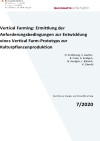
Im Mittelpunkt stand die Erforschung von Grundlagen für eine neue Gebäudetypologie, der Vertikalen Farm. Urbane vertikale Lebensmittelproduktion kann zur Steigerung der Energieeffizienz von und zur Reduktion des Landverbrauchs durch Städte beitragen. Wesentliche Einflussfaktoren zur Erreichung dieser Ziele werden durch diese Grundlagenforschung offen gelegt.
Schriftenreihe
7/2020
D. Podmirseg, S. Sautter, B. Cody, A. Keutgen, N. Keutgen, J. Balasch, K. Diwold
Herausgeber: BMK
Deutsch, 91 Seiten
Downloads zur Publikation
50 grüne Häuser - Entwicklung und Demonstration eines Low-Tech-Grünfassadensystems
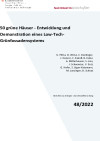
Entwicklung einer kostengünstigen gewerke- und prozessübergreifenden All-In Gebäudebegrünung inkl. Wartungskonzept ("Greening-Toolkit") zur breiten (vor allem straßenseitigen) Implementierung auf Fassaden im städtischen Bestand, kombiniert mit einer Prozessinnovation zur Vereinfachung aller notwendigen Abstimmungsprozesse.
Schriftenreihe
48/2022
U. Pitha, O. Weiss, C. Dantinger, J. Dunzer, C. Kaindl, B. Kainz, A. Mitterhauser, S. Lins, J. Schwanzer, V. Enzi, G. Hofer, S. Jäger-Katzmann, M. Lanzinger, B. Schoas
Herausgeber: BMK
Deutsch, 100 Seiten
Downloads zur Publikation
Urbane Grünraumpotenziale iM verBauten BestAnd (Urbane GmbA)
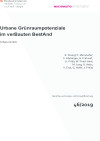
Urbane GmbA hat zum Ziel, das Grünflächenpotenzial am Gebäude- und im verbauten Bestand (vertikal und horizontal) in Wien zu sondieren, verfügbare Erhebungsinstrumente in den Projektgebieten anzuwenden und Forschungs- und Entwicklungsbedarfe für grüne Infrastrukturen aufzuzeigen.
Schriftenreihe
46/2019
R. Stangl, P. Minixhofer, S. Hörbinger, G. Frühwirt, U. Pitha, W. Friesl-Hanl, M. Jung, G. Heiss, V. Enzi, G. Hofer, J. Preiss
Herausgeber: BMVIT
Deutsch, 133 Seiten
Downloads zur Publikation
Raum & Grün - Möglichkeiten zur Integration von Begrünung ins Regelwerk der österreichischen Raumordnung
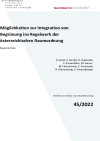
In der F&E-Dienstleistung „Raum & Grün“ wurde eine Studie erstellt, welche die Zusammenhänge zwischen Raumordnung und Begrünung abbildet, den Handlungsbedarf sowie -spielraum von Akteurinnen und Akteuren zeigt sowie konkrete Empfehlungen formuliert, wie innovative Stadtbegrünungen und Bauwerksbegrünungen effektiv in das Regelwerk der österreichischen Raumordnung und Raumplanung verankert werden können.
Schriftenreihe
45/2022
B. Knoll, A. Renkin, R. Dopheide, E. Knasmillner, M. Karner, M. Fleischmann, S. Formanek, R. Werluschnig, G. Kienastberger
Herausgeber: BMK
Deutsch, 92 Seiten
Downloads zur Publikation
greening UP! Nachhaltige Grünpflege, Wartung, Instandhaltung von Vertikalbegrünungen inklusive rechtlicher Aspekte
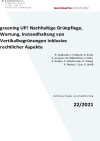
Im Projekt wurden aufbauend auf umfassenden Erhebungen und Analysen von bestehenden vertikalen Gebäudebegrünungen in Außenräumen (boden- und systemgebundene Fassadenbegrünungen) und vertikalen Innenraumbegrünungen passgenaue Grünpflege-, Wartungs- und Instandhaltungskonzepte erarbeitet und rechtliche Aspekte adressiert. Der "greening UP!"-Wissenspool mit konkreten Empfehlungen und anschaulich aufbereitetem Wissen sowie die Konzeption eines digitalen Tools zur "Ersten Grünen Hilfe" runden das Projekt ab.
Schriftenreihe
22/2021
R. Dopheide, J. Hollands, B. Knoll, A. Korjenic, M. Mitterböck, U. Pitha, A. Renkin, F. Schiefermair, R. Stangl, P. Skolek, I. Süss, O. Weiß
Herausgeber: BMK
Deutsch, 162 Seiten
Downloads zur Publikation
50 green houses - Development and demonstration of a low-tech façade greening system
Development of a cost-efficient all-in façade greening system („Greening-Toolkit“) including a maintenance concept, involving all trades and processes, for a broad (facing roads) implementation on facades in the urban built environment, combined with a process innovation for simplification of all necessary coordination processes.
Green and Resilient City - Management and planning tools for a climate-sensitive urban development
The aim of the project was to provide a "proof of concept" of a control loop and tool set for the management, optimization and evaluation of green and climate-sensitive urban (district) planning- The tool set consist of urban and open space planning instruments as well as climate simulations at different scale levels.
greening UP! Sustainable green maintenance, maintenance, maintenance of vertical greenery including legal aspects
Based on extensive surveys and analyses of existing vertical building greenery in outdoor areas (floor and system-bound façade greening) and vertical interior greenery, the project developed tailor-made green care, maintenance and repair concepts and addresses legal aspects. The "greening UP!" Knowledge pool with concrete recommendations and clearly presented findings as well as the conception of a digital tool for the "First Green Aid" complete the project.
Edible Seestadt - Green Seestadt - Learning for the Edible City of the Future
"Edible Seestadt" ("Essbare Seestadt") identifies which contributions an edible city provides for a climate-neutral resilient district and how this contribution can be sustainably stabilized and optimized.
Space & Green. Possibilities for integrating greening into the regulations of Austrian spatial planning
The R&D service "Raum & Grün" (Space & Green) prepared a study that depicts the interrelationships between spatial planning and greening, shows the need for action and the scope for action by actors, and formulates concrete recommendations on how innovative urban greening and greening of buildings can be effectively anchored in the regulations of Austrian spatial planning.
Smart Pölten 2.0 Holistic view on a Vertical Farm in preparation for a demonstration project for the city of St. Pölten
The city of St. Pölten forsees great potential in Vertical Farming with regard to the objectives related to the concept of the Smart City program - linking local food production, quality of life by reducing resource consumption. This has to be evaluated by combining Vertical Farms with existing living buildings. Eco-social and socio-economic considerations play an important role in this process.
GrünStattGrau – Innovations for Greening Cities "The green living laboratory"
GrünStadtGrau represents the holistic of competence for green building technologies such as green roofs and living walls in Austria. It generates impulses for urban green infrastructure on buildings and links innovative products and projects, supports through know-how and analysis for implementation processes. GrünStattGrau guides urban and participatory strategies from development to implementation.
Biotope City - construction manual for the green city of the future
"Biotope City" is an overall concept for the implementation of comprehensive urban greening with the aim of using the regenerative mechanisms of nature. With this approach, quality of life is to be comprehensively, sustainably and cost-effectively increased and resilience against extreme weather events in cities will be improved. The project aims to generate realistic components of a "construction manual" for the green city of the future, which are generalizable and transferable.
Urbane GmbA - Urban potential of greenable area in the obscured stock
Urbane GmbA aims to explore and assess the potential of greenable area from building and obscured stock (vertical and horizontal areas) in Vienna, to apply currently available survey instruments and to show research and development needs.
SUPERBE - Potential of Superblock-concepts as contribution to planning energy-efficient urban quarters
The exploratory study SUPERBE for the first time looks into the applicability and potential effects of Superblock concepts in an Austrian urban context in order to assess their contribution to energy-oriented urban planning.
VERTICAL FARMING - Investigation on requirements of a Vertical Farm-prototype development for crop plant production
In the center of interest stands the investigation of fundamental principles for a new building typology – the Vertical Farm. Urban vertical food production can contribute to more energy efficient cities by concurrently reducing land use. Substantial influencing factors to achieve these goals are intended to be revealed.
PVOPTI-Ray, Optimization of reflecting materials and photovoltaics in urban environment with respect to energy balance and bioclimate.
Within the scope of the project PVOPTI_Ray the influence of reflection and energy balance on the performance of building integrated photovoltaics (PV) in complex urban environment have been investigated. Equally the influence of PV modules and of the energy conversion of solar energy at the PV module surface has an impact on micro climate and therefore also on pedestrians who are exposed to the radiation fluxes. This was also investigated.
LooPi - the autonomous unisex plant-based urinal for public spaces
Application of the prototype in the operational environment for a period of 20 months. Technical monitoring thoughout the cycle of seasons, user interviews concerning satisfaction, evaluation of the potential use of LooPi material streams as soil conditioner for organic farming. Results serve the development towards market maturity.
